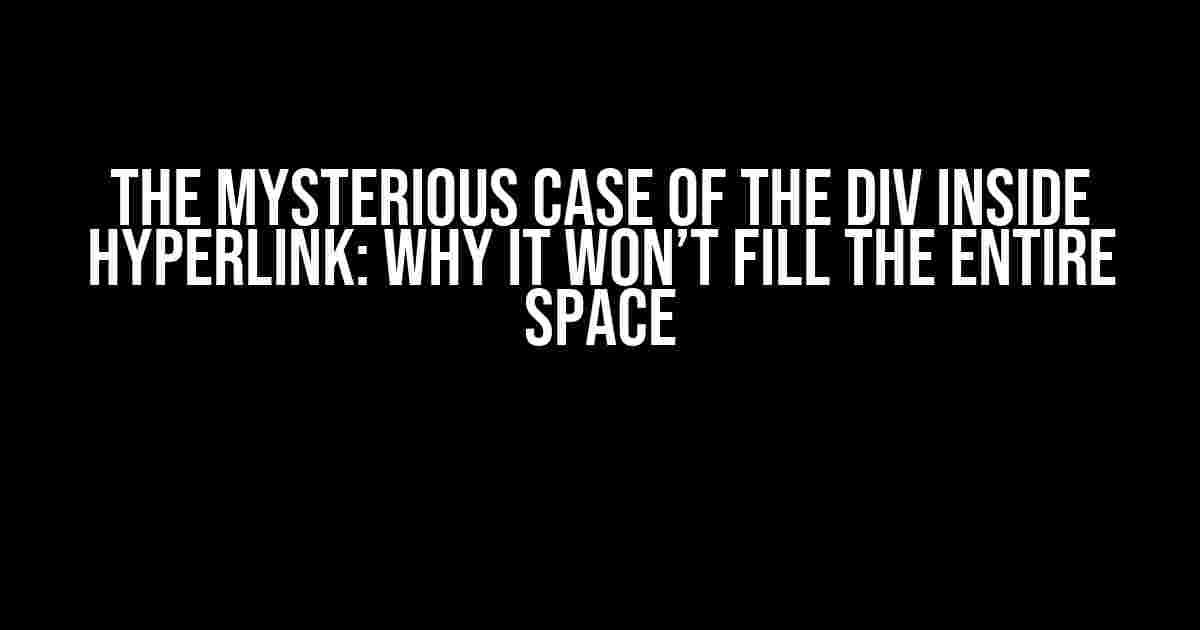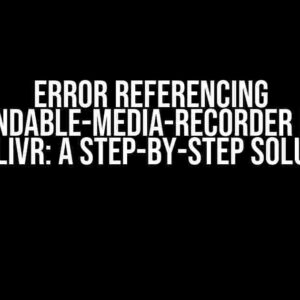Are you tired of banging your head against the wall, wondering why your div inside a hyperlink refuses to fill the entire space? You’re not alone! Many web developers have stumbled upon this issue, and today, we’re going to unravel the mystery behind it. Buckle up, folks, as we dive into the world of HTML and CSS to explore the reasons and solutions to this pesky problem.
What’s the Issue?
Before we dive into the solution, let’s understand the problem. You have a hyperlink ( tag) containing a div element (or any other block-level element). You want the div to occupy the entire space within the hyperlink, but it doesn’t. Instead, it only takes up the space required to display its content, leaving the remaining area empty. This can be frustrating, especially when you’re trying to create a visually appealing design.
<a href="#">
<div>
This div should fill the entire space, but it doesn't!
</div>
</a>
Why Does This Happen?
To understand why this occurs, we need to delve into the world of HTML and CSS. The primary reason behind this issue is the way browsers interpret the display properties of elements. When you place a div inside a hyperlink, the div becomes an inline element by default. This means it only takes up the space required to display its content, ignoring the surrounding hyperlink’s dimensions.
Display Properties 101
In HTML, elements are classified into two categories: block-level elements and inline elements. Block-level elements, like div, p, and h1, occupy the full width of their parent container and start on a new line. Inline elements, like span, a, and img, occupy only the space required to display their content and do not start on a new line.
When you place a div (block-level element) inside a hyperlink (inline element), the div becomes an inline element itself. This means the div will not take up the entire space within the hyperlink, as it’s now subject to the rules of inline elements.
Solutions to the Problem
Now that we understand the root cause, let’s explore the solutions to make the div fill the entire space within the hyperlink.
1. Display: Block
One way to tackle this issue is by setting the display property of the div to block. This will allow the div to occupy the entire space within the hyperlink.
<a href="#" style="display: inline-block;">
<div style="display: block;">
Now this div will fill the entire space!
</div>
</a>
2. Display: Flex
Another approach is to use the display property with a value of flex. This will make the div a flexible container, allowing it to occupy the entire space within the hyperlink.
<a href="#" style="display: inline-flex;">
<div style="display: flex;">
Now this div will fill the entire space!
</div>
</a>
3. Width and Height
If you want to maintain the div’s inline nature, you can set its width and height to 100%. This will make the div occupy the entire space within the hyperlink.
<a href="#" style="display: inline;">
<div style="width: 100%; height: 100%;">
Now this div will fill the entire space!
</div>
</a>
Advanced Scenarios
So far, we’ve covered the basic scenarios. But what if you need to add more complexity to your design? Let’s explore some advanced scenarios.
Table Layout
Imagine you want to create a table-like layout within the hyperlink, where the div occupies the entire space.
<a href="#" style="display: table;">
<div style="display: table-cell; width: 100%;">
Now this div will fill the entire space!
</div>
</a>
Nested Elements
What if you need to add nested elements within the div, and you want them to occupy the entire space as well?
<a href="#" style="display: inline-block;">
<div style="display: block;">
<div style="display: block; width: 100%;">
Now this nested div will fill the entire space!
</div>
</div>
</a>
Common Pitfalls
When dealing with div inside hyperlinks, it’s essential to avoid common pitfalls that can lead to undesired results.
-
Not setting the display property: Failing to set the display property of the div can lead to it not occupying the entire space within the hyperlink.
-
Not considering the parent element’s display property: Make sure to set the display property of the parent element (in this case, the hyperlink) to accommodate the div’s layout.
-
Not accounting for padding and margins: Be mindful of padding and margins when setting the width and height of the div, as they can affect its overall size.
Conclusion
The mystery of the div inside the hyperlink not filling the entire space has been solved! By understanding the display properties and utilizing the right CSS techniques, you can make your div occupy the entire space within the hyperlink. Remember to consider the parent element’s display property, padding, and margins to achieve the desired result.
With these solutions and advanced scenarios, you’ll be well-equipped to tackle any design challenge that comes your way. Happy coding, and don’t let the div inside hyperlink mystery haunt you again!
| Solution | Code |
|---|---|
| Display: Block | <a><div style="display: block;"></div></a> |
| Display: Flex | <a><div style="display: flex;"></div></a> |
| Width and Height | <a><div style="width: 100%; height: 100%;"></div></a> |
-
Test your code in different browsers to ensure compatibility.
-
Use the browser’s developer tools to inspect the element and identify any issues.
-
Experiment with different display properties and values to achieve the desired result.
Here are the 5 Questions and Answers about “div inside hyperlink does not fill the entire space” with a creative voice and tone:
Frequently Asked Questions
Get the scoop on why that div just won’t fill up that hyperlink!
Why does my div inside a hyperlink not fill the entire space?
This is because the div is an inline element by default, and it only takes up the space needed for its content. To make it fill the entire space, you can add `display: inline-block` or `display: block` to the div’s CSS, depending on your layout requirements.
How do I make the div take up the full width of the hyperlink?
Easy peasy! Just add `width: 100%` to the div’s CSS, and it will take up the full width of the hyperlink. If you want it to take up the full height as well, add `height: 100%` too!
Why does adding display: block not work in this case?
When you make the div a block element with `display: block`, it will take up the full width of its parent, but it won’t necessarily fill the entire space of the hyperlink. This is because the hyperlink is still an inline element, and it doesn’t have a specified width or height. To make the div fill the entire space, you need to add `display: inline-block` or use flexbox or grid layout.
How do I make the div fill the entire space of the hyperlink in a responsive design?
For a responsive design, you can use flexbox or grid layout to make the div fill the entire space of the hyperlink. For example, you can add `display: flex` and `flex-grow: 1` to the hyperlink, and then add `flex-basis: 0` to the div. This will make the div take up the full width and height of the hyperlink, while also being responsive to different screen sizes.
What if I want to add padding or margin to the div inside the hyperlink?
No problem! Just add the padding or margin to the div as you normally would. However, keep in mind that the padding or margin will be added to the div’s width and height, so you may need to adjust the width and height accordingly to make sure the div still fills the entire space of the hyperlink.



